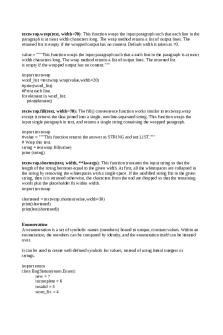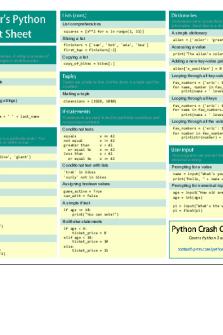Assignment 1 - astar search, code in python PDF

| Title | Assignment 1 - astar search, code in python |
|---|---|
| Course | Artificial Intelligence Survey |
| Institution | Simon Fraser University |
| Pages | 4 |
| File Size | 80.4 KB |
| File Type | |
| Total Downloads | 29 |
| Total Views | 139 |
Summary
astar search, code in python...
Description
CMPT 310 - Artificial Intelligence Survey Assignment 1 Due date: February 8, 2021 10 marks
J. Classen January 25, 2021
Important Note: Students must work individually on this, and other CMPT 310, assignments. You may not discuss the specific questions in this assignment, nor their solutions with any other student. You may not provide or use any solution, in whole or in part, to or by another student. You are encouraged to discuss the general concepts involved in the questions in the context of completely different problems. If you are in doubt as to what constitutes acceptable discussion, please ask!
Software Most of the assignments will be using Python 31 , and you should install the aima-python2 code on your computer (including the sample data sets). Follow the installation instructions on the aima-python page. Since aima-python uses Git, it makes sense to download the code through Git.
The 8-Puzzle In this assignment you get a chance to experiment with some (informed) search algorithms. In the aima-python repository, take a look at the class called EightPuzzle. Take some time to read and understand it, including the Problem class that it inherits from. Put the coding part of your answers to the following questions in a Python 3 file named a1.py that starts like this: # a1.py from search import * # ... Do not use any modules or code except from the standard Python 3 library, or from the textbook code from Github. 1 2
https://www.python.org/ https://github.com/aimacode/aima-python
1
Question 1: Helper Functions
(2 marks)
Write a function called make rand 8puzzle() that returns a new instance of an EightPuzzle problem with a random initial state that is solvable. Note that EightPuzzle has a method called check solvability that you should use to help ensure your initial state is solvable. Write a function called display(state) that takes an 8-puzzle state (i.e. a tuple that is a permutation of (0, 1, 2, ..., 8)) as input and prints a neat and readable representation of it. 0 is the blank, and should be printed as a * character. For example, if state is (0, 3, 2, 1, 8, 7, 4, 6, 5), then display(state) should print: * 3 2 1 8 7 4 6 5
Question 2: Run A∗ with Statistics
(2 marks)
By default, the A∗ implementation in aima-python uses the misplaced-tiles heuristic. In your program, include top-level code such that when the program is executed, it creates a random 8-puzzle problem instance (using your code above), prints the instance, and solves it by means of A∗ . Afterwards, it should report: • the total running time for the search algorithm in seconds; • the length (i.e. number of tiles moved) of the solution; • the total number of nodes that were expanded during search. You will probably need to make some modifications to the A∗ code to get all this data. Also, be aware that the time it takes to solve random 8-puzzle instances can vary from less than a second to hundreds of seconds (see hints below)! Modify your program such that the user can optionally provide the initial state for a problem instance on the command line. For example, to solve (0, 3, 2, 1, 8, 7, 4, 6, 5), the program should be called using $ python3 ai.py 0 3 2 1 8 7 4 6 5 If no instance is given, the program instead creates the random instance as described above.
Question 3: Manhattan Distance Heuristic
(2 marks)
Write a function manhattan(n) that implements the Manhattan distance heuristic, taking a Node n as its argument. Extend your top-level code such that it additionally runs A∗ using this heuristic function. Be careful: there is an incorrect Manhattan distance function in tests/test search.py. Don’t use that, but implement your own (correctly working!) version. 2
Question 4: Gaschnig’s Heuristic
(2 marks)
One relaxation of the 8-puzzle is the assumption that a tile can move from one square to the blank position directly, even if it is not a neighbouring square. The exact solution of this problem defines Gaschnig’s heuristic. Implement it in a function called gaschnig(n), and again extend your top-level code such that it additionally runs A∗ with this heuristic.
Question 5: Compare Algorithms
(2 marks)
Create 10 (more would be better!) random 8-puzzle instances (using your code from above), and solve each of them using the 3 different heuristics for the A∗ algorithm. Each version should be run on the exact same set of problems to make the comparison fair. Write a PDF document in which you discuss your results. It should at least contain a (single) table that summarizes your data. Be sure to include helpful descriptive statistics like the min, max, average, and median values. You are also encouraged to include helpful or informative graphs of your data. Furthermore, in your PDF, answer the following questions: • Based on your data, can you give a recommendation for what you think is the best algorithm? Explain how you came to your conclusion. • Is it possible to rule out one of the heuristic functions without looking at experimental data, but purely based on theoretical consideration? Hint: We say that an admissible heuristic h1 is at least as accurate as another admissible heuristic h2 iff for every n, h1 (n) ≥ h2 (n). • Can you suggest a heuristic that is always at least as accurate as all 3 heuristic functions discussed here?
What to Submit Please put all your code into a single Python 3 file named a1.py, all your data, tables, charts, discussion, etc. in a PDF file named a1.pdf, and submit them on Canvas before the due date listed there. If you want to make changes to code in search.py, or in files other than a1.py, please copy the code you want to change into a1.py, and change it there. Don’t make any changes to other files in the textbook code.
Hints • When you are testing your code, you might want to use a few hard-coded problems that don’t take too long to solve. Otherwise, you may spend a lot of time waiting for tests to finish! 3
• One easy way to time code is to use Python’s standard time.time() function, e.g.: import time def f(): start_time = time.time() # ... do something ... elapsed_time = time.time() - start_time print(f’elapsed time (in seconds): 0.2811s’) Python has other ways to do timing, e.g. check out the timeit module. • To process command line arguments, use the sys module: import sys print(’Number of arguments: ’, len(sys.argv)) print(’Argument List: ’, sys.argv) Running the above as file test.py using $ python test.py arg1 arg2 arg3 yields Number of arguments: 4 Argument List: [’test.py’, ’arg1’, ’arg2’, ’arg3’] Note that the filename of the program is considered the first argument. • If you download the textbook code as a Git repository, then you can create a branch called a1 for this assignment, e.g. something like: $ git branch a1 git checkout a1 This way you can make any changes you like while maintaining a copy of the original code. You are not required to use Git, but since the code is stored as a Git repository, it’s probably the best way to get it. 4...
Similar Free PDFs

Python 1st assignment
- 8 Pages

CHATBOT IN PYTHON
- 40 Pages

Conditional Threads in Python
- 2 Pages

Text wrap in Python
- 5 Pages

Mc simulation in python
- 8 Pages

Python In a Nutshell
- 93 Pages
Popular Institutions
- Tinajero National High School - Annex
- Politeknik Caltex Riau
- Yokohama City University
- SGT University
- University of Al-Qadisiyah
- Divine Word College of Vigan
- Techniek College Rotterdam
- Universidade de Santiago
- Universiti Teknologi MARA Cawangan Johor Kampus Pasir Gudang
- Poltekkes Kemenkes Yogyakarta
- Baguio City National High School
- Colegio san marcos
- preparatoria uno
- Centro de Bachillerato Tecnológico Industrial y de Servicios No. 107
- Dalian Maritime University
- Quang Trung Secondary School
- Colegio Tecnológico en Informática
- Corporación Regional de Educación Superior
- Grupo CEDVA
- Dar Al Uloom University
- Centro de Estudios Preuniversitarios de la Universidad Nacional de Ingeniería
- 上智大学
- Aakash International School, Nuna Majara
- San Felipe Neri Catholic School
- Kang Chiao International School - New Taipei City
- Misamis Occidental National High School
- Institución Educativa Escuela Normal Juan Ladrilleros
- Kolehiyo ng Pantukan
- Batanes State College
- Instituto Continental
- Sekolah Menengah Kejuruan Kesehatan Kaltara (Tarakan)
- Colegio de La Inmaculada Concepcion - Cebu







![OOP [Python] - Test #1 - Python test #1](https://pdfedu.com/img/crop/172x258/gwrwjez6mm21.jpg)

